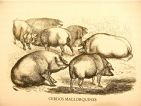
Pigs
 "Included amongst the sacrificed pigs are the porcelles or suckling pigs, the preferred delicacy at Christmas in both Palma and many other towns. We can distinguish those killed for public sale and those for personal reserves of fat, sausages, etc. This custom is so widespread on the island that we would not err in estimating that ninety of every hundred people carry out their own pig slaughter. There are even towns where the number of pigs slaughtered privately is greater than the number of families, thus sacrificing more than one animal. Consequently, pigs sacrificed privately partly outnumber those destined for public sale in markets except in Palma.
"Included amongst the sacrificed pigs are the porcelles or suckling pigs, the preferred delicacy at Christmas in both Palma and many other towns. We can distinguish those killed for public sale and those for personal reserves of fat, sausages, etc. This custom is so widespread on the island that we would not err in estimating that ninety of every hundred people carry out their own pig slaughter. There are even towns where the number of pigs slaughtered privately is greater than the number of families, thus sacrificing more than one animal. Consequently, pigs sacrificed privately partly outnumber those destined for public sale in markets except in Palma.
In the statistical information from 1856, there are relatively many more owners of pigs than lambs. This is due, in general, that there aren’t large herds of pigs on any part of the island. Rather, many people raise only one pig for their own use or to sell it. Many poor farmers fatten a pig to earn extra income to cover the costs which their daily wages don’t cover, for example, the rent of their home, the garden they tend, their clothes or debt they may have contracted. With little money they can acquire a young pig. They let it forage for some time and then fatten it with whatever they have available or forage which costs little. When the animal has reached the desired weight, its owners take the first opportunity to sell it to the highest bidder. This explains why there are many pig owners and why, on Mallorca, this animal represents a domesticated animal in the strictest sense of the word. We often see them running around here and there, from the corral behind the house to the nearby garden where they have a trough made of olive tree roots.
On Mallorca there is only one known breed of pig considered autochthonous, and it is very similar to the one from Ibiza. It is different, nevertheless, from the peninsular breed and is more like the one we find in southern Italy. These animals are completely black and have large ears. Some are eye-catching and distinguished by very large warts on their chins, absent on others. The special trait of the Mallorcan breed is the ease with which it is fattened, requiring relatively less food than needed by other breeds. In addition, they are distinguished because almost all their fat is later turned into lard. Lastly, of all the pig breeds we find in Spain, it seems that the Mallorcan breed is the one offering the most meat and fat in proportion to bones and intestines."
Archduke Ludwig Salvator of Austria. Las Baleares por la palabra y el grabado. Majorca: General Part. Ed. Sa Nostra, Caja de Baleares. Palma de Mallorca. 1982.


















